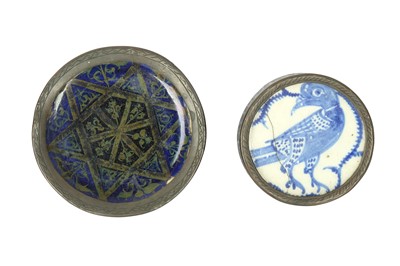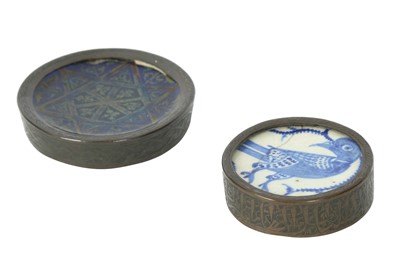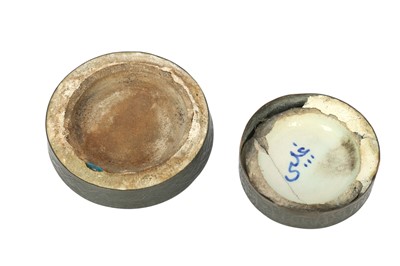16th Jul, 2021 14:00
Islamic & Indian Art
TWO POTTERY TILE FRAGMENTS
Damascus, Syria, 13th century and Fustat, Cairo, Egypt, 15th century
TWO POTTERY TILE FRAGMENTS
Damascus, Syria, 13th century and Fustat, Cairo, Egypt, 15th century
Comprising a circular fragment of a Syrian cobalt blue-glazed and copper lustre-painted pottery vessel, decorated with a six-pointed star and leafy sprays, the hexagonal centre divided in smaller rhomboidal cartouches filled with more vegetal motifs, encased within a copper band engraved with knotwork decoration, 11.5cm diam.; and a similarly-shaped Fustat sherd, painted in cobalt blue against a white ground, decorated with a bird perched on a branch, the back signed in Arabic "Ghaibi", encased within a copper band engraved with calligraphy, 9cm diam.
Both fragments share similarities with pottery vessels and sherds typically associated with the 13th - 15th-century pottery production of Syria and Egypt under the Mamluk Empire. Similar examples can be seen in the Kuwait National Museum. For further reference, please check O. Watson, Ceramics from Islamic Lands, 2004, p. 396, cat. R.1 and p. 418, cat. S.2. In the latter example, one of the sherds bears a cobalt blue-painted bird, possibly a peacock, and is signed at the back Ghaibi in the same fashion as our sherd. According to Watson, Ghaibi is the best-known Egyptian potter of the 15th century. However, due to the great variety of pieces bearing this mark, it has been suggested that the name is indicative of a workshop rather than an individual, and it may have been employed by a number of decorators working in Egypt (Ibidem, pp. 418 - 419).
Sold for £812
Includes Buyer's Premium
Do you have an item similar to the item above? If so please click the link below to submit a free online valuation request through our website.




